- MENU
- HOME
- SEARCH
- WORLD
- MAIN
- AFRICA
- ASIA
- BALKANS
- EUROPE
- LATIN AMERICA
- MIDDLE EAST
- United Kingdom
- United States
- Argentina
- Australia
- Austria
- Benelux
- Brazil
- Canada
- China
- France
- Germany
- Greece
- Hungary
- India
- Indonesia
- Ireland
- Israel
- Italy
- Japan
- Korea
- Mexico
- New Zealand
- Pakistan
- Philippines
- Poland
- Russia
- South Africa
- Spain
- Taiwan
- Turkey
- USA
- BUSINESS
- WEALTH
- STOCKS
- TECH
- HEALTH
- LIFESTYLE
- ENTERTAINMENT
- SPORTS
- RSS
- iHaveNet.com: Vacation Travel
by Bo Zaunders
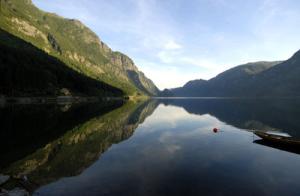
Hesitant at first, my wife bit into it gingerly, pronouncing it "bland but quite oily."
She had been handed a fish pellet and, more or less, ordered to eat it -- the implication being that in a place as rigorously eco-friendly as this, what's good enough for a fish is good enough for human consumption.
A circuitous route through breathtaking fjord country had taken us to the Hardanger Akvasenter, a salmon farm in the small community of Steinsto, a 90-minute drive from Bergen.
The Akvasenter exemplified the very latest and most advanced in Norwegian fish farming.
Standing in front of one of the tanks, and watching the swirls from surfacing fish, we were told that this particular tank contained 60,000 salmon. A controlled environment, indeed: not only were temperature and oxygen distribution kept at specific levels through sophisticated computer programming, cameras had been placed in each corner of the tank, allowing for visual supervision at all times. In a room that looked rather like a research station or a laboratory, an employee turned on a monitor, and we found ourselves staring into the eyes of an unsuspecting salmon.
The place was absolutely spotless, leaving us with the notion that -- who knows -- a salmon may not have to be wild to be delicious.
Our Norwegian venture began when we took the train from Oslo to Bergen.
Choosing rail proved auspicious. I've always liked trains.
They are (in Europe anyway) comfortable and relaxing, even luxurious. And you can enjoy the scenery with not the slightest concern about oncoming traffic. Speaking of scenery, we had heard that the views would be spectacular during this six and a half hour journey across Norway's mountainous midriff.
Suffice it to say, they were.
[ Related: Norway's Ultimate Natural Thrill ]
Apples Galore in Norway
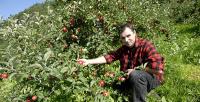
Though stunningly beautiful with its high mountains and deep fjords, this is not a country conducive to easy living.
Throughout history, Norwegians have been forced to squeeze every advantage out of what for the most part is an unforgiving land -- a condition fostering strong work ethics.
Newfound oil riches notwithstanding, the typical Norwegian is still a hardy character, intolerant of waste.
This was brought to mind when we ran into Arnvid Steinso, a local fruit grower.
We met at the Steinsto Frukt & Kakebu, a roadside cafe, where we had stopped for coffee and apple pie. Arnvid happened to be there, and took me on a short walk through his nearby apple orchard.
It was a lovely morning.
Below I caught glimpses of the Hardanger fjord; the sky was a bright blue, the trees an intense green, and there were apples everywhere, the color of which, coincidentally, matched the vivid reds of Arnvid's checkered shirt.
The area, he told me, is the northernmost venue for apples in Europe. "I grow 25 varieties," he said, "and 15 kinds of pears." Other fruits were strawberries, raspberries, and cherries. All in all, his annual production is more than 32,000 pounds.
Back at the Kakebu, Arnvid's father showed up to lend a helping hand with the apples. I learn that monks in the Middle Ages introduced fruit growing in Hardanger, and that Steinsto farm had been in the family for eight generations.
Utne Hotel - The oldest hotel in Norway
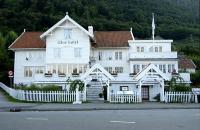
That afternoon we took a ferry to the small town of Utne, where a room awaited us at the Utne Hotel, the oldest hotel in Norway still in operation.
Housed in a beautiful white wooden building, it was established in 1722, and has, for nearly 300 years, been a natural stopping place for people traveling to Bergen.
Both Roxie and I found the place fascinating, a throwback in time with its old-world feel and atmosphere. After a visit to the nearby Hardanger Folk Museum -- where a scene with a wedding party in traditional costumes sitting in a long narrow boat particularly caught my attention -- we sat down for a specially prepared dinner in the hotel's old dining room.
Whale meat and kusk may not sound overly mouth-watering, but both were delicious. The whale, cut in thin slices and served as an appetizer, tasted rather like a cross between Carpaccio and roast beef, and the kusk, which is a cod-like fish indigenous to the area, reminded me of monkfish. As the main dish, it was served with julienne carrots, boiled potatoes, and reduced red-wine sauce, and was followed by a raspberry sorbet with fresh mint, and a razor-thin leaf of dark chocolate. And throughout the meal, we drank an excellent Italian red house wine.
Deep Into Norway's Rural History
The next day, zigzagging our way south, we became increasingly aware of how firmly rooted the people around here are in history and tradition.
First there was Sjur Jaastad at the Hardanger Cideri, another hardworking individual involved with apples, whose final product proved wonderfully refreshing.
Next came Agatunet, an idyllic farm hamlet with some 35 or 40 buildings dating from medieval to modern times. While there, we were served traditional Norwegian food at an old-fashioned farm. It was here, I believe, that we were first introduced to lefse, a Norwegian delicacy, which with almost uncanny regularity would show up on our table the next few days. We felt honored, since lefse (a soft flatbread made out of potato, cream and flour and cooked on a griddle), is reserved for special occasions only. You roll it up in butter and sugar, sometimes with cinnamon, and have it with coffee.
At Agatunet, the conversation soon turned to Queen Sonja's visit in 2005, when Norway celebrated its 100th year of independence from Sweden. Hearing that I was Swedish, it was suggested that I take a look at the stone that had been erected in commemoration of this happy occasion. I saw it, and felt no regret -- it had been such an uneasy union to begin with.
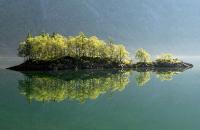
We spent the night in Odda. The next morning we were off again, following the Ryfylke road along the Lake Roldalsvatnet, and looking for signs to Sand.
Paddling for Pancakes in Norway
So there we were, in rubber rafts, oar in hand, paddling down the salmon-rich Suldalslagen River.
In charge of the expedition was Bjorn Moe, an entrepreneurial Norwegian who, apart from owning the Mo Laksegard Hotel where we were staying, took visitors on salmon safaris and river expeditions. Perfect for the job, he exuded a warm comfortable air and wore a wide-brimmed leather hat picked on a recent trip to Australia. With us were about 30 schoolteachers, all gathered together to bond before the school opened.
And bond they did. After an hour or so of just the right degree of exertion in churning waters, we pulled up on a riverbank for a welcome respite. There, next to a picturesque Laplander tent, Bjorn lighted a campfire, made coffee and tea, and handed out frying pans and pancake mix for anyone interested in making pancakes.
Most did. Soon, the clean Nordic air filled with cooking smells and the happy chatter of bonding schoolteachers.
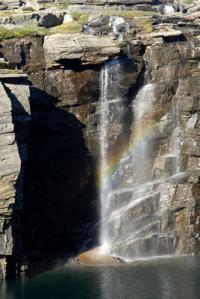
The expedition concluded with a tour of Sandfossen waterfall and the adjacent Laksestudio. There, a large underwater window allowed us to watch salmon in their natural environment, fighting their way upstream to spawn.
That evening Bjorn showed me his small brewery.
His beer, he said, was produced strictly according to renhetsloven, the purity law, which decrees that a beer must contain no more than four ingredients: water, barley, hops, and yeast.
"No pasteurization,' he stated, saluting me with a raised glass of delicious homemade beer.
Later, in the hotel's dining room, the Mo Laksegard, we ate roast lamb, expertly prepared by Bjorn's mother. There we met Charles, who for three days had stood knee-deep in the Suldalslagen River, concentrating on the fine art of angling. British to the core and with a somewhat superior attitude, he expounded of the psychology of salmon, making little drawings on paper napkins to explain their erratic behavior. The fish must have known what they were doing, however, since, despite their multitude, Charles, the expert fisherman, had yet to catch a single salmon.
The following morning, we met with Greta and Rognald Stuhaug, caretakers of Stuhaug Turisme & Gardsmuseum in Sandeid, just south of Mo Laksegard. Like Agatunet, Stuhaug is a collection of old timber houses, reverently restored, and crammed with antique furniture, tools, and other artifacts from the past 400 years. Rognald proved an engaging guide, and Greta, dressed in folk costume, served us coffee and lefse at a long table, beneath heavy beams with painted garlands of flowers.
A warm farewell, and we were on the road again, heading for a hotel in Haugesund, and for a visit to Avaldnes, one of the most sacred places in all of Norway.
Where Norway Began
Avaldsnes, some contend, is where Norway began, the first place to bear its name -- Nordvegen, the North Way -- and where Harald Finehair set up his main estate after unifying the country in A.D. 872. Occupying the site now is a medieval church and various burial mounds, one of which is the Cow-mound. Long before Harald there was King Augvald, a powerful man who traced his ancestry back to the Giants, and whose strength and vitality came from drinking the milk of his Holy cow. Whether the mound really is the cow's final resting place is unclear -- it may contain Augvald, or both of them.
In Avaldnes -- on the island of Karmoy -- a short walk took us to the Viking Farm on the small island of Bukkoy, where we stumbled upon a so-called Long House, complete with a dragon's head on the roof. Other artifacts were on display in the mysterious semi-darkness of its interior, and all around stood reconstructed buildings from the Viking age. A great tourist attraction from March to October, the Viking Farm also serves as a very special school for children. Here, in Viking outfits and transported back in time a thousand years, children engage in various farm activities, such as the construction of fences, textile work, and preparation of the day's dinner. And in the evening, as they gather around the fireplace to eat their own prepared meal, they listen to old Norse sagas, to music and to poetry. Altogether, the emphasis is on Vikings as farmers, fishermen, craftsmen, and poets, not as pirates and barbarians. Absent in the teaching is the terror that made all Europe shudder, and gave raise to the expression: "From the fury of the Northmen deliver us, O Lord."
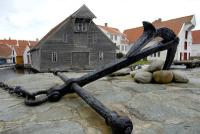
Continuing south, we stopped at Skudenshavn, a pretty little harbor town at the southern tip of Karmoy.
"We grew with the herring and lobster," said one of its inhabitants. I could well believe it. Everywhere you looked you felt the presence of the sea, from window decorations with maritime motifs to a colossal anchor sculpture in one of the town squares. Speaking of anchors, even a fire hydrant I saw was shaped like one. The great son of Skudenshavn is Ole Christian Hansen (1885-1935). Not surprisingly, he was a foghorn inventor.
Norway's Cultural Capital
Now to Stavanger, the last major stop on this leisurely trip down western Norway -- and the city chosen as the 2008 European Capital of Culture.
Arriving just in time for dinner, we went directly to Sjohuset Skagen, a landmark restaurant next to the quay, across from Stavanger's old town. There, in a converted warehouse reminiscent of the Hanseatic quarters in Bergen, we ate a commendable meal of salmon and catfish garnished with mussels.
In Stavanger, as in Skudenshavn, herring was once king. A reflection of the prosperity that came with the herring trade can be seen in the old town, with its 173 (almost all privately owned) white houses, most of which were built in the 18th and 19th centuries. True to character, and sticking to fish even after the herring trade dwindled in the late 1800s, Stavanger subsequently became the world's pre-eminent manufacturer of canned sardines, with, at one point, 72 canning factories.
Cheese, Blackberries and Scaling Norway's Eikefjellet
The next and final day of our Norwegian venture was packed with action, beginning with a three and a half hour sightseeing cruise on Lysefjord, during which we passed Preikestolen, the Pulpit Rock, a much photographed plateau some 2,000 feet above sea level.
After the cruise we met with Hans Voll, a cheese-maker of the highest order, whose factory with its gleaming copper forms and rows upon rows of lovely cheeses bespoke of utter professionalism and unmistakable pride. And Mr. Voll had good reason to be proud. The Voll Ysteri, though quite small, with only one employee, has won two gold medals (in 2003 and 2005) in the national exhibition for farm cheese. His product, the cheese of Jaeren, he said, is the first authorized cheese produced from raw, un-pasteurized milk in Norway.
Our day concluded with a foray into the Ryfylke archipelago for a date on the island of Halsnoy with yet another enterprising individual in the fruit business. She was Sofie Bjerga Roth, a former chef and caterer, who grows organic blackberries, which she sells to private stores in the region. Standing in one of her greenhouses, we were offered a sampling of what a blackberry should taste like. Delicious indeed. Her annual production is 5,000 kg, and she's thinking of expanding her business to include raspberries and blueberries.
Before embarking on this trip, phrases such as "eco-friendly", "natural produce," "green environment," had seemed little more than politically correct buzzwords. Now they had real meaning and significance. Here, in western Norway, we had found the fruits of land and sea in as pure a form as you're ever likely to get them in this modern age.
After our visit to the greenhouse, Sofie and her friend Hanne took us on what I imagined would be a short walk on Holsnoy Island. I should have known better. The Norwegians are a hardy race, combining a boundless love of nature with a craving for hardship. Before we knew it, in deteriorating weather, we were climbing Eikefjellet, an exceedingly steep 2,000-foot mountain. Rain was imminent and soon it would be dark. Halfway up, I excused myself on the grounds that there would be no photo ops in the woods above. But Roxie (who works out in a gym almost every day) was not to be deterred. As I prudently returned to the car, she valiantly followed our newfound friends all the way to the top.
An hour and a half later, three bedraggled women showed up in almost total darkness. Roxie sighed with relief; Sofie and Hanne giggled with happiness. What could be more invigorating than a good tramp in the woods?
Only in Norway.
Getting to Norway
For a train ride, such as the one we took from Oslo to Bergen, I recommend www.raileurope.com. There you can check schedules, book reservations, and buy rail passes.
Flying SAS from the U.S., you can go to either Oslo or Bergen via Copenhagen. www.flysas.com.
Where to Stay in Norway
In Bergen, we stayed overnight at Radisson SAS Hotel Norge, which is within easy walking distance to Bryggen, the medieval Hanseatic wharf, as well as the famous Fish Market and the funicular that takes you to Mount Floyen, from where you have a spectacular view of the city. www.radisson.com.
- Utne Hotel, +47 53 66 10 88, www.utne-hotel.no.
- Vasstun Guesthouse, Odda, 47 49 00 44 86/ +47 55 09 28 00, www.vasstun.no.
- Mo Laksegard, Sand, Ryfylke, 47 52 79 90, www.molaks.no.
- Clarion Collection Hotel Amanda, Haugesund, +47 52 80 82 00.
(Just a few doors from the hotel we found Lothes Mat & Vinhus, a commendable little restaurant that takes enormous pride in using the very best of local produce. Its upstairs dining room is quite cozy and boasts a good view of the city.)
- Rica Park Hotel, Prestegardsbakken 1 Stavanger, +47 51 50 04 00, www.rica.no.
[ Related: Norway's Ultimate Natural Thrill ]
Adventure Travel in Western Norway - Fish & Fjords - Norwegian Vacations & Travel
Article: Copyright ©, Tribune Media Services Inc.